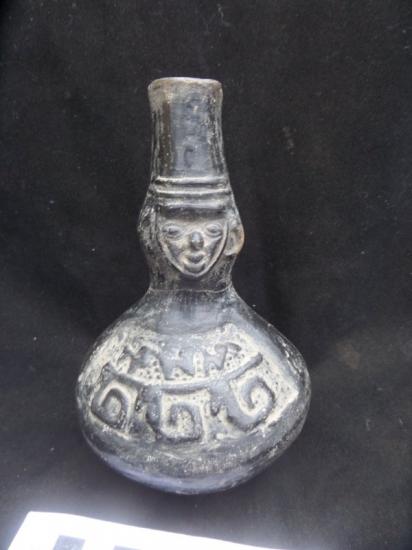PART.3

Detailed view of circular room wall at Ashipucoto. Photo credit Kimberly Munro.

Archaeologist and project co-director Jeisen Navarro mapping the interior circular room in Ashipucoto. Photo credit Kimberly Munro.

The mounds align on a nearly north-south axis. Courtesy Kimberly Munro and the Cosma Archaeological Project.
Looking Ahead
The end of the 2014 season barely made a dent in what the Cosma team still had before them—a complex of ceremonial mounds, domestic structures, burials, and other features that altogether likely span a period of over 3,000 years, most of which still remains hidden beneath overgrowth and soil. But it was an auspicious start.
“Plans for next year are to expand our excavations at Karecoto," says Munro. "I'd like to put in a larger trench to see if we can locate the stairway up the mound summit, and the end of the underground gallery. Our 2014 findings have shown us that Karecoto was mainly utilized during the Initial Period (1800/1500 BCE – 900 BCE) and Early Horizon, and the final capping episode on the mound summit happened during the Early Horizon. We located two separate floor levels, but due to the soil composition, which is very compact, very hard clay, we were only able to get down 9 feet within Karecoto. The mound was mapped at 18 meters high. So our understanding of the complexity of this structure is still very minimal.“
At Ashipucoto, Munro and colleagues want to continue excavating the circular room to identify internal elements and features and recover artifacts. Because this room was found on the west side of the mound, the team also has plans to excavate another large unit on the other side of the mound to determine if there are any other rooms or structures.
For the third mound, Kunka, time simply ran out. It remains relatively unexplored. But in 2015, they plan to dig a test pit there to establish the chronology. “Surface artifacts and architecture initially made us believe this mound is of later construction (Early Intermediate Period), but we won't know for sure till we are able to peel back the layers of the mound,” says Munro.
Ultimately the reseachers want to expand on the work here to develop an understanding of the nature and complexity of inter-regional interactions in the upper Nepeña valley, the overall geographic context of the Cosma sites. Cosma will be a key to developing this understanding, not the least of which is the alluring mystery of its location: “The site is located in an isolated area that is hard to reach. Why was a major monumental center constructed in that area instead of along one of the major prehistoric trade routes of the valley?” asks Munro. The key might rest within the bigger picture of what was happening here in terms of the sociocultural dynamics. “I'd really like to help shed light on intermediary zones and their importance within larger scale politics and interaction networks.”

Stone points found during excavations at Karecoto. Courtesy Kimberly Munro and the Cosma Archaeological Project.

Ceramic effigy fragment recovered from Ashipucoto. Courtesy Kimberly Munro and the Cosma Archaeological Project.

Ceramic panpipe fragment recovered from Karecoto. Courtesy Kimberly Munro and the Cosma Archaeological Project.

Chimú face-neck vessel shown to team by local community member, originally recovered from Ashipucoto. Courtesy Kimberly Munro and the Cosma Archaeological Project.
Readers who are interested in learning more about the Cosma Archaeological Project or who desire to participate in the excavations are encouraged to go to the project website.